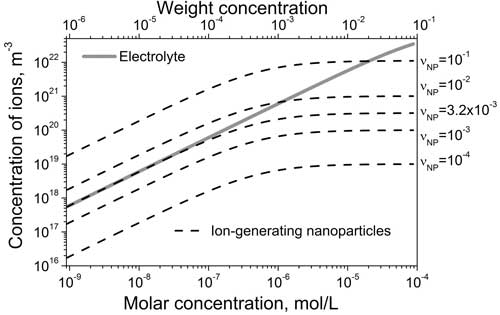| Mar 04, 2020 | |
The analogy between electrolytes and ion-generating nanomaterials in liquid crystals |
|
| (Nanowerk Spotlight) Liquid crystals are typically associated with liquid crystal displays (LCD). LCD technology has become ubiquitous in digital calculators, watches, cell phones, computer monitors, and flat screen televisions. Nowadays we are witnessing an increasing competition between LCD and alternative display technologies such as organic light-emitting diode (OLED) displays. | |
| This ongoing competition results in the development of improved LCD technologies (think of high resolution liquid crystal on silicon displays for virtual and augmented reality), and also stimulates rapid growth of non-display applications through tunable liquid crystal components such as for instance filters for biomedical imaging and ophthalmic corrective lenses. | |
| Both display and non-display applications of liquid crystals rely on advanced liquid crystal materials. Liquid crystal materials with new functionalities can be produced by dispersing nanomaterials in liquid crystals, resulting in a mixture of nano-dopants and liquid crystals. | |
| These novel, nanotechnology-based materials very often exhibit unusual properties. For that reason, nanomaterials in liquid crystals are a hot topic of contemporary liquid crystal research and many research teams around the world carry out basic research in this field. | |
| "An understanding of the effects of nanomaterials on the properties of liquid crystals is of utmost importance, because if we do not understand the basic science, we cannot take advantage of it," Yuriy Garbovskiy, Assistant Professor in the Department of Physics and Engineering Physics at Central Connecticut State University, tells Nanowerk. | |
| In his research, Garbovskiy is looking to uncover hidden and overlooked properties of nanomaterials in liquid crystals. We have covered some of his work in previous Nanowerk Spotlights that discuss how ion-generating properties of nanomaterials can originate from their ionic contamination. | |
| The ionic contamination of nanomaterials, which can be a very important factor in how liquid crystals perform, may seem very unusual and unpredictable. At the same time, the consequences of this contamination are predictable and can be studied. In the long run, an understanding of mechanisms and processes responsible for ion-generating properties of nanomaterials will enable a broad range of both display and non-display applications of liquid crystals doped with nanomaterials. | |
| Garbovskiy's recent paper, published in Nanomaterials ("On the Analogy between Electrolytes and Ion-Generating Nanomaterials in Liquid Crystals"), focuses on the electrical behavior of nanomaterials in liquid crystals. More specifically, he considers ion-generating properties of nanoparticles in liquid crystals. | |
 |
|
| Steady-state concentration of ions generated in liquid crystals by electrolytes (solid curve) and ion-generating nanomaterials (dashed curves) as a function of their molar/weight concentration. (Source: https://doi.org/10.3390/nano10030403; distributed under the Creative Commons Attribution License) | |
| In this paper, Garbovskiy establishes an analogy between ion-generating nanomaterials and electrolytes in liquid crystals as a simple quantitative model. At the same time, it can predict the complex electrical behavior of ion-generating nanomaterials in liquid crystals. This generation of ions can be very efficient, comparable to or even stronger than the generation of ions by electrolytes. | |
| "At first glance, this type of behavior of nanomaterials may seem unusual and even counter-intuitive," Garbovskiy points out. "Yet, there are several experimental reports unambiguously showing the existence of ion-generating behavior of nanomaterials in liquid crystals." | |
| The implications are quite interesting. One application area for liquid crystals doped with nanomaterials could be the development of smart windows. The transmittance of smart windows – between transparent and opaque states – can be controlled by applying a voltage across it. Ions are typically required for this application. In the past, electrolytes (salts) were added to liquid crystals to generate ions. It might now be feasible that ion-generating nanomaterials can also be used in addition to or even instead of electrolytes. | |
| The ion-generating properties of nanomaterials in liquid crystals provide a broad range of research and applied opportunities and systematic experimental studies are required to uncover the basic mechanisms of this phenomenon. | |
| "The range of possible applications is practically unlimited, spanning both display and non-display applications of liquid crystals," says Garbovskiy. "Why? Because in the majority of cases liquid crystal devices are driven by electric fields. Ions can change that field– (in the simplest case think of a screening effect. That is why an importance of our understanding of the electrical behavior of nanomaterials in liquid crystals cannot be overestimated." | |
| "An understanding of ion generating properties of nanomaterials in liquid crystals could enable the control over their electrical properties; and this line of research is a tricky one," he adds. "To give you an example, nanomaterials of the same composition synthesized using different chemical routes can behave quite differently in liquid crystals." | |
| "Future directions for this research field are very broad," Garbovskiy concludes. "The holy grail of nanomaterials in liquid crystals is the achievement of a deep understanding of fundamental physical properties of such systems, enabling their versatile applications in a form of commercial products. The collective efforts of scientists and engineers move the field forward, closer to this goal." | |
 By
Michael
Berger
– Michael is author of three books by the Royal Society of Chemistry:
Nano-Society: Pushing the Boundaries of Technology,
Nanotechnology: The Future is Tiny, and
Nanoengineering: The Skills and Tools Making Technology Invisible
Copyright ©
Nanowerk LLC
By
Michael
Berger
– Michael is author of three books by the Royal Society of Chemistry:
Nano-Society: Pushing the Boundaries of Technology,
Nanotechnology: The Future is Tiny, and
Nanoengineering: The Skills and Tools Making Technology Invisible
Copyright ©
Nanowerk LLC
|
|
|
Become a Spotlight guest author! Join our large and growing group of guest contributors. Have you just published a scientific paper or have other exciting developments to share with the nanotechnology community? Here is how to publish on nanowerk.com. |
|
